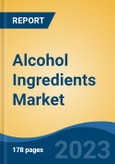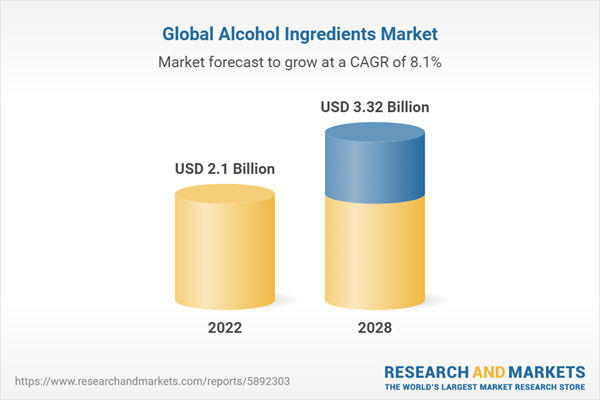Free Webex Call
The Global Alcohol Ingredients Market reached a value of USD 2.10 billion in 2022 and is expected to experience strong growth in the forecast period, with a Compound Annual Growth Rate (CAGR) of 8.1% through 2028. The alcohol ingredients market represents a dynamic and essential segment within the broader alcoholic beverage industry. It encompasses a wide range of components that contribute to the creation of various alcoholic products. These ingredients play a pivotal role in determining the flavor, aroma, texture, and overall quality of alcoholic beverages, spanning from beer and wine to spirits and liqueurs. Speak directly to the analyst to clarify any post sales queries you may have.
10% Free customizationThis report comes with 10% free customization, enabling you to add data that meets your specific business needs.
The alcohol ingredients market comprises several key categories, including yeast, grains & fruits, hops, and botanicals & spices, each serving a distinct purpose in beverage production:
- Yeast is a microorganism crucial for the fermentation process, converting sugars into alcohol and carbon dioxide. Different yeast strains are used for various alcoholic beverages, imparting unique flavors and characteristics.
- Grains like barley, corn, and rye, along with fruits like grapes, form the foundation of many alcoholic beverages. Their sugars are fermented by yeast to create alcohol, and their flavors contribute to the final product's profile.
- Hops are essential for beer production, imparting bitterness, aroma, and flavor. Different hop varieties are used to create a spectrum of beer styles.
- In the realm of spirits and liqueurs, botanicals and spices such as juniper, coriander, and citrus peels add complexity and distinctiveness to the final product, crucial for creating diverse flavors in gin, vermouth, and other distilled spirits.
However, sourcing high-quality ingredients consistently can be challenging due to factors like weather conditions, climate changes, and supply chain disruptions. Ensuring a stable supply of ingredients is essential for maintaining product consistency. Compliance with varying regulations across different regions poses a challenge for manufacturers and suppliers, particularly for imported ingredients. Meeting consumer demands for innovative flavors while maintaining product quality requires constant experimentation and balancing market trends with traditional techniques.
Key Market Drivers
1. Evolving Consumer Preferences and Demand for Premium Experiences: Consumer preferences within the alcohol industry are undergoing a transformative shift. Modern consumers are seeking unique and premium experiences, prompting the demand for high-quality, distinctively flavored alcoholic beverages. Craft cocktails, artisanal spirits, and customized concoctions have gained popularity as consumers seek novel taste profiles and sensory experiences. This driver has opened doors for innovative alcohol ingredients that cater to diverse palates. Natural flavor extracts, botanical infusions, and exotic fruits are being integrated to create bespoke spirits and cocktails. Additionally, consumers are increasingly drawn to transparent sourcing and production methods, encouraging manufacturers to incorporate authentic, high-quality ingredients that align with consumers' desire for premium and ethically produced products.2. Craft Distillation and Microbrewing Trends: The rise of craft distillation and microbrewing has revolutionized the alcohol industry. Consumers are drawn to the authentic, artisanal appeal of small-batch production methods, which often prioritize quality over mass production. This trend has created a demand for unique, locally sourced ingredients that set craft spirits and beers apart from mass-produced alternatives. Craft distilleries and microbreweries experiment with a wide array of ingredients, ranging from specialty grains and fruits to botanicals and spices. This driver encourages creativity and innovation in the alcohol ingredients market, as manufacturers provide the raw materials necessary to create distinctive and complex flavor profiles. As consumers explore new taste experiences, this trend offers an opportunity for ingredient suppliers to cater to the evolving demands of artisanal producers.
3. Culinary Cross-Pollination and Mixology Mastery: The art of mixology has grown beyond traditional cocktails to encompass a fusion of culinary techniques, flavor pairings, and creative presentations. Mixologists are borrowing from the culinary world, incorporating fresh herbs, exotic spices, and innovative flavor combinations to craft innovative drinks that appeal to the senses. This driver has led to a demand for a wide range of alcohol ingredients, including natural extracts, syrups, bitters, and garnishes. Ingredients such as infused syrups made from real fruits, herbs, and spices enable mixologists to elevate their creations with sophisticated flavors. Culinary-inspired cocktails and 'farm-to-glass' concepts have pushed ingredient suppliers to provide a diverse array of ingredients that seamlessly bridge the gap between the kitchen and the bar.
Key Market Challenges
1. Regulatory Compliance and Stringent Standards: Navigating the regulatory landscape is one of the most critical challenges facing the alcohol ingredients market. Alcoholic beverages are subject to a web of regulations and standards that vary by country, region, and product type. These regulations encompass aspects such as labeling, health claims, advertising, and safety standards. Ensuring compliance with these regulations is essential to market entry, consumer trust, and brand reputation. Furthermore, the rapid evolution of these regulations, including shifts in labeling requirements, permissible ingredients, and taxation policies, creates uncertainty for manufacturers and impacts formulation decisions. For example, the increasing demand for transparency in labeling, including nutritional information and ingredient sourcing, poses challenges for manufacturers to adapt their labeling practices accordingly. Manufacturers must invest in regulatory expertise and robust quality control measures to navigate this challenge successfully. Collaborations with regulatory bodies and industry associations can help stakeholders stay updated on changes and advocate for industry-friendly regulations. Innovations in ingredient sourcing, such as organic or sustainably grown ingredients, can also provide a competitive advantage in an environment where consumer preferences for transparency and responsible practices are growing.2. Consumer Preferences and Health Considerations: Consumer preferences for healthier and more natural products are reshaping the alcohol ingredients landscape. Health-conscious consumers are seeking beverages with reduced sugar content, lower calories, and fewer artificial additives. This presents a challenge for manufacturers that must balance the desire for healthier options with preserving the traditional flavors and characteristics that define alcoholic beverages. Moreover, the rise of mindful drinking and alcohol alternatives, driven by factors like health, moderation, and social responsibility, challenges the conventional consumption patterns of alcoholic beverages. The alcohol ingredients market must adapt to these shifting consumption behaviors while maintaining the essence of the product. The challenge of catering to evolving consumer preferences also presents opportunities for innovation. Manufacturers can explore alternatives like natural sweeteners, herbal extracts, and botanicals that offer unique flavors while addressing health concerns. Moreover, developing alcohol-free or low-alcohol products aligned with consumer preferences for moderation can expand market reach and tap into a growing segment of mindful drinkers.
3. Sustainability and Environmental Impact: As sustainability becomes a focal point across industries, the alcohol ingredients market is grappling with the challenge of minimizing its environmental footprint. Ingredients used in alcoholic beverages, such as grains for distillation or fruits for flavoring, require agricultural resources and contribute to carbon emissions. Additionally, the waste generated in production processes poses challenges for responsible waste management and resource optimization. Consumers are increasingly considering the environmental impact of their purchases, driving the demand for sustainable practices throughout the supply chain. Addressing this challenge requires reevaluating sourcing methods, production techniques, packaging materials, and waste management practices to align with sustainable goals.
Report Scope:
In this report, the global alcohol ingredients market has been segmented into the following categories, in addition to the industry trends which have also been detailed below:Alcohol Ingredients Market, By Ingredient Type:
- Yeast
- Enzymes
- Colorants
- Flavors & Salts
- Others
Alcohol Ingredients Market, By Beverage Type:
- Beer
- Spirits
- Wine
- Whisky
- Brandy
- Others
Alcohol Ingredients Market, By Region:
- North America
- United States
- Canada
- Mexico
- Asia-Pacific
- China
- India
- Japan
- South Korea
- Australia
- Europe
- Germany
- France
- United Kingdom
- Italy
- Spain
- South America
- Brazil
- Argentina
- Colombia
- Middle East & Africa
- Saudi Arabia
- UAE
- South Africa
- Turkey
Competitive Landscape
Company Profiles: Detailed analysis of the major companies present in the global alcohol ingredients market.Available Customizations:
Global Alcohol Ingredients Market report with the given market data, the publisher offers customizations according to a company's specific needs.This product will be delivered within 1-3 business days.
Table of Contents
1. Introduction
2. Research Methodology
3. Executive Summary
4. Voice of Customer Analysis
5. Global Alcohol Ingredients Market Outlook
6. North America Alcohol Ingredients Market Outlook
7. Europe Alcohol Ingredients Market Outlook
8. Asia-Pacific Alcohol Ingredients Market Outlook
9. Middle East & Africa Alcohol Ingredients Market Outlook
10. South America Alcohol Ingredients Market Outlook
11. Market Dynamics
12. Impact of COVID-19 on Global Alcohol Ingredients Market
14. Porter’s Five Forces Model
15. SWOT Analysis
16. Competitive Landscape
17. Strategic Recommendations/Action Plan
Companies Mentioned
- Cargill, Incorporated
- Archer Daniels Midland Company
- Ashland Inc.
- D.D. Williamson & Co. Inc.
- Koninklijke Dsm NV
- Kerry Group PLC
- Treatt PLC
- Chr Hansen Holdings A/S
- Sensient Technologies Corporation
- Dohler Group
Table Information
| Report Attribute | Details |
|---|---|
| No. of Pages | 178 |
| Published | November 2023 |
| Forecast Period | 2022 - 2028 |
| Estimated Market Value ( USD | $ 2.1 Billion |
| Forecasted Market Value ( USD | $ 3.32 Billion |
| Compound Annual Growth Rate | 8.1% |
| Regions Covered | Global |
| No. of Companies Mentioned | 10 |









